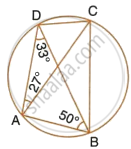Advertisements
Advertisements
प्रश्न
In the given figure, if ∠ ACE = 43° and ∠CAF = 62°. Find the value of a, b, and c.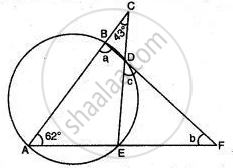
उत्तर
ABCE is cyclic quadrilateral.
∴ ∠ ABD + ∠ AED = 180°
and ∠ EAB + ∠ BDE = 180°
Now in Δ ACE
∠ A + ∠ C + ∠ E = 180°
62° + 43° + ∠ E = 180°
∠ E = 180° - 105° = 75°
So,
∠ ABD + ∠ AED = 180°
∴ a + 75° = 180°
∴ a = 105°
∠ EDF = ∠ BAE ....(Exterior angle of cyclic quadrilateral)
∴ 62° = c
∴ c = 62°
In Δ ABF,
∠ ABF + ∠BAF + ∠BFA = 180°
∴ 105° + 62° + b = 180°
∴ 167° + b = 180°
∴ b = 180° - 167°
∴ b = 13°
a = 105°, b = 13° and c = 62°
APPEARS IN
संबंधित प्रश्न
PQRS is a cyclic quadrilateral. Given ∠QPS = 73°, ∠PQS = 55° and ∠PSR = 82°, calculate:
1) ∠QRS
2) ∠RQS
3) ∠PRQ
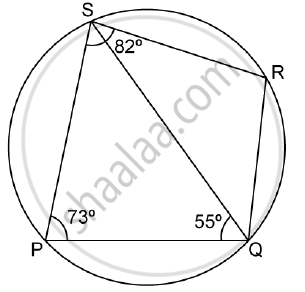
In cyclic quadrilateral ABCD, ∠DAC = 27°; ∠DBA = 50° and ∠ADB = 33°.
Calculate:
- ∠DBC,
- ∠DCB,
- ∠CAB.

In the figure, ABCD is a cyclic quadrilateral with BC = CD. TC is tangent to the circle at point C and DC is produced to point G. If ∠BCG = 108° and O is the centre of the circle, find :
- angle BCT
- angle DOC

In the given figure, AB is the diameter of a circle with centre O. ∠BCD = 130°. Find:
(i) ∠DAB
(ii) ∠DBA
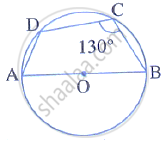
The quadrilateral formed by angle bisectors of a cyclic quadrilateral is also cyclic. Prove it.
If two non-parallel sides of a trapezium are equal, it is cyclic. Prove it. Or An isosceles trapezium is always cyclic. Prove it.
In the given figure, ABCD is a cyclic quadrilateral. AF is drawn parallel to CB and DA is produced to point E. If ∠ADC = 92°, ∠FAE = 20°; determine ∠BCD. Give reason in support of your answer.

In a cyclic quadrilateral ABCD , AB || CD and ∠ B = 65 ° , find the remaining angles
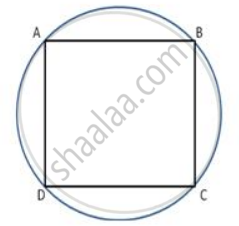
In a cyclic quadrialteral ABCD , if m ∠ A = 3 (m ∠C). Find m ∠ A.
In cyclic quadrilateral ABCD, ∠DAC = 27°; ∠DBA = 50° and ∠ADB = 33°. Calculate : ∠CAB.
